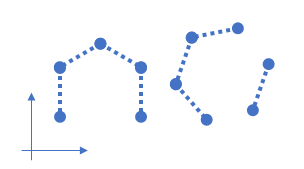Skip to first unread message
hr.hei...@gmail.com
Jan 14, 2019, 12:17:51 PM1/14/19
to Manopt
Hi,
Would it be possible to use Manopt to optimize a cost function on a subgroup of SO(2 or 3) and SE(2 or 3)?
My question is specifically about the Point group (https://en.wikipedia.org/wiki/Point_group) in which we have different kinds of symmetry around an specific axis (or axes) of rotation(s) together with translation in 2D/3D Euclidean space.
Best regards,
Hamidreza
Nicolas Boumal
Jan 15, 2019, 7:59:40 AM1/15/19
to Manopt
Hello Hamidreza,
No such subgroups are currently implemented, but if they are indeed smooth manifolds then in principle it should be possible (and perhaps not hard) to add support for them.
Can you tell us more about these sets?
Also, I'd be interested in knowing in what context they arise.
Best,
Nicolas
hr.hei...@gmail.com
Jan 15, 2019, 10:11:57 AM1/15/19
to Manopt
Thanks for your quick answer.
Actually, these subgroups are mostly studied in the context of crystallography and molecular biology where we have certain structures with different point groups. The most basic one are n-fold rotational symmetry group in which rotation by an angle of 360°/n around a fixed point or around the axis of rotation does not change the object of interest (for n=1, there is no symmetry and it is equivalent to SO(3) or SE(3)).
What I am currently interested in is a subgroup of SE(3) such that its rotation group belong to one of these n-fold symmetry group.
It would be great if you can add the support for these groups to your library or help me to figure out how it would be possible to do that.
Best regards,
Hamidreza
Nicolas Boumal
Jan 15, 2019, 12:02:55 PM1/15/19
to Manopt
Hello Hamidreza,
Thanks for the details.
It seems that the symmetries at play here are discrete symmetries, in that each group element is equivalent to a finite number of other group elements (at least for the rotational part), as opposed to being equivalent to a whole submanifold of group elements.
Did I get that right or not?
If that understanding is correct, then the "quotient space" would not have particularly exploitable smooth geometry.
Perhaps, if it is easy to write down a description of one of the simplest (but non-trivial) point groups that you are interested in, I may get a clearer picture.
Best,
Nicolas
Hamidreza Heydarian
Jan 29, 2019, 1:51:35 PM1/29/19
to Nicolas Boumal, Manopt
Dear Nicolas,
Thanks for your reply.
Maybe it would be better that I elaborate on this with a simple example:
Imagine that we want to match two incomplete shapes with the prior knowledge that they are both having 6-fold symmetry (hexagon):

If we choose a proper metric for matching these two shapes, for example L2 norm, the naive search space would be in SE(2) for an angle (in [0, 2*pi]) and two translation elements. However, this naive search space does not take into account that indeed the search space is a subgroup of SE(2). Actually, any multiples of pi/6 around their axis of rotation, are the same.
From another perspective, angles are belonging to a cyclic group with a period of 2*pi, what do we need to change if we are in a group for which this period is 2*pi/k where k is an integer?
I hope that this example clarify what I am looking for.
Best regards,
Hamid
--
http://www.manopt.org
---
You received this message because you are subscribed to a topic in the Google Groups "Manopt" group.
To unsubscribe from this topic, visit https://groups.google.com/d/topic/manopttoolbox/ENR6SnKLCms/unsubscribe.
To unsubscribe from this group and all its topics, send an email to manopttoolbo...@googlegroups.com.
Visit this group at https://groups.google.com/group/manopttoolbox.
To view this discussion on the web visit https://groups.google.com/d/msgid/manopttoolbox/31ce1c15-47a1-45f5-ad92-602d06ee2dbd%40googlegroups.com.
For more options, visit https://groups.google.com/d/optout.
Nicolas Boumal
Jan 29, 2019, 2:06:48 PM1/29/19
to Manopt
Hello Hamidreza,
Thanks for the explanation. This indeed confirms what I understood.
The symmetry at hand here is discrete, so there isn't much smooth geometry to exploit.
I have a question though: does it actually hurt if the search is done over [0, 2pi) instead of [0, 2pi/k) ? Surely, the cost function in your optimization problem has the desired symmetry, so that it shouldn't really matter in which "branch" of the circle we are, does it? Also, numerically, I wouldn't anticipate this to cause trouble.
Best,
Nicolas
To unsubscribe from this group and all its topics, send an email to manopttoolbox+unsubscribe@googlegroups.com.
Reply all
Reply to author
Forward
0 new messages
